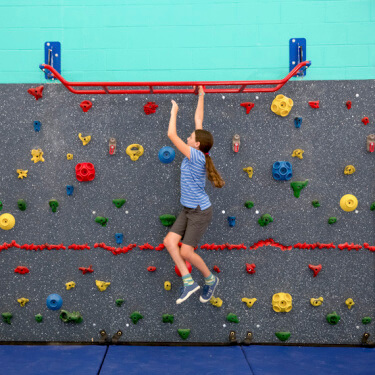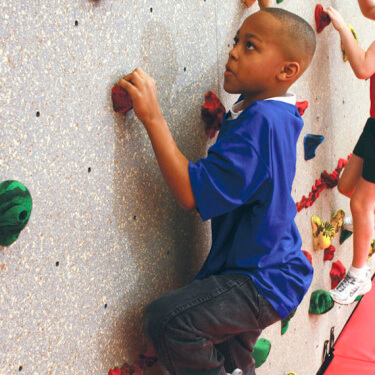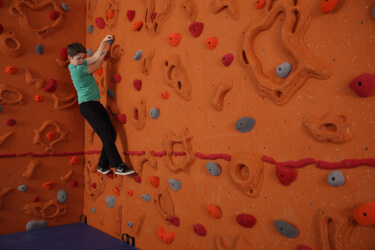Activity Provides Numerous Physical and Emotional Benefits
Physical education teachers who have spent decades teaching traditional exercise activities are now focusing on the vast benefits offered by climbing walls.

“Climbing walls are excellent for building upper body strength and improving balance, endurance and flexibility, as well as encouraging cooperation and team building with others,’’ said Pat Simon, coordinator of athletics and physical education for Milford Public Schools in Milford, Conn. “When a student makes it across the wall, it builds their self-esteem. It’s working out well at our school and this activity is catching on across the country.’’
Simon, who has been teaching physical education at the Live Oaks Elementary School in Milford for 38 years, uses the traverse wall during classes for students in kinder- garten through fifth grade. Climbing walls are also used at two additional elementary schools and two middle schools in the Milford District.
Traverse climbing walls challenge students to travel horizontally along the panels, overcoming any obstacles they may encounter along the way and collaborating with other students who are simultaneously testing their own maneuverability on the makeshift mountain.
“It’s an outstanding program that can be used for students of all fitness levels,’’ noted Simon. “Three special education classes use the wall, too, so students with different levels of disability can participate to some extent. Certain rocks on the wall are only a foot off the ground and some students are able to stand up by holding onto the rocks and pulling themselves up.’’

Live Oaks purchased the climbing wall more than two years ago, but the activity is still relatively new at West Carthage Elementary School in Carthage, N.Y. Marty Weaver, a physical education teacher for kindergarten through fifth grade, said the school began using the traverse wall in the fall of 2006. So far, the wall has only been used for second through fifth grade. However, first grade is expected to be introduced to the fun experience during the 2007-08 academic year.
“We were looking for alternative, non-traditional activities and the climbing wall is an opportunity for all students to participate and benefit even if they are not athletic,’’ said Weaver, who has been teaching physical education for 25 years. “There are vast differences between traversing the wall and playing traditional team sports, which typically don’t carry on past high school. We wanted an activity like rock climbing that students could take with them after they graduate from high school and benefit from for a lifetime.’’
Weaver believes the climbing walls are becoming increasingly popular throughout the United States because they have a unique appeal to students. In addition, they provide tremendous fitness benefits as part of an activity that is more fun than doing the standard pushups and pull-ups of years gone by.
“The highest a student’s feet can be off the ground is three feet, but it still encourages risk taking and requires problem solving,’’ said Weaver. “Teachers can also be very creative and give students special challenges as they cross the wall. For example, we have hooked students together with hula hoops and they had to hold rubber chickens while they were crossing. What they do on the wall reveals a lot about their character and how they interact with others.’’
Despite the clever ways by which physical education teachers may add pizzazz to the wall, the activity provides the utmost safety. Traverse walls are typically eight feet high and students climb across them without the need for any ropes, harnesses or other special equipment. The walls are safer than playgrounds where students can often climb to heights exceeding three feet. Padded mats are used to provide a comfortable landing surface and enhanced safety for the climbers.
Weaver first became interested in obtaining a climbing wall when he attended a physical education conference where the walls were on display. Now, the wall is drawing a lot of attention and is even being used at the school’s family night events where any family member of a student can test their level of coordination, balance and determination on the wall.
“Our wall cost about $7,000, but it will benefit countless students and will be a long-lasting part of our physical education program,’’ added Weaver. “It can also be used for cross-curricular activities and as an education tool. For instance, students may have to solve a math problem on a dry-erase board while they are on the wall.’’

Climbing is an activity that can boost the self-esteem of all students. Weaver said students with physical handicaps and learning disabilities are able to perform certain activities that they would not otherwise be able to without the wall. One of his students has Prader Willi Syndrome, a condition characterized at birth by the lack of spontaneous movements and protective reflexes. The syndrome often leads to severe obesity in young children.
“This student was able to hold herself on the wall for about 30 seconds and that was a big step,’’ he recalled. “Sometimes, you have to be creative to make it work by doing things such as putting spots on the floor and the students have to coordinate their feet with the marks on the floor and their hands with the rocks on the wall. This worked very well with a student who only has the use of one arm.’’
Weaver advises teachers who currently do not have a wall in their class to visit a school where climbing is part of the activities. Seeing is truly believing when a child’s face lights up when he or she crosses the wall or takes even a few steps.
“It represents a unique activity in a physical education class and it requires thinking outside the box. The wall levels the playing field for all students because you don’t have to be athletic to do it,’’ said Weaver.
The Louisiana State University Laboratory School in Baton Rouge was thinking outside the box long before many other institutions when it purchased a wall approximately seven years ago. Joanna Faerber, who currently teaches kindergarten, third and fifth grades, has been a physical education teacher for 23 years. The wall is part of the physical education curriculum for students in kindergarten through 12th grade.
The school began with a traverse wall, but now uses a top- rope design to give students even more of a challenge. The top-rope walls provide a vertical climbing challenge and can be custom-designed to fit any facility and built with a variety of surfaces. The top-rope walls designed by Everlast Climbing Industries Inc. in Mendota Heights, Minn., can be mounted on a wall or used as freestanding fixtures.
“We want our students to be risk takers and to try new things in life,’’ said Faerber. “When a kindergartner climbs to the top and comes back down, that’s exciting. If students are exposed to new and interesting activities when they are in elementary school, they won’t be afraid to try new things when they get older.’’
She said climbing helps students set goals and decide which steps must be taken to achieve those objectives. In addition to the psychological and emotional benefits, climbing can promote long-term upper body strength that often leads to better posture which, in turn, equates to stronger abdominal and back muscles, as well as a healthier heart and lungs.
Faerber has witnessed firsthand the positive impact that climbing can have on students at various developmental and physical stages in their lives. She recalls a kindergarten student with a learning disability and attributes his improvement to being able to traverse the wall. After climbing on the wall, he wrote about the experience in his school journal — the first time he had written in his journal for months.
“Climbing gives students a sense of pride. We want all children no matter what their physical ability or reading ability to experience reaching a goal,’’ said Faerber.
